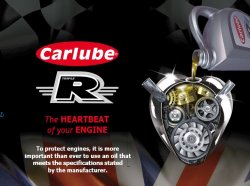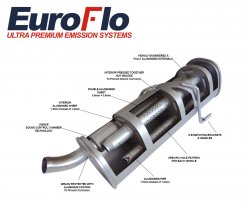Professionals to DIY
We're Online 9am - 5pm
On Orders Over £30
Carlube Triple R Premium Engine Oils

To protect car engines, it is more important than ever to use a high quality engine oil that meets the specifications stated by the vehicle manufacturer.
Beckermann Engine Management Sensors

Camshaft & Crankshaft Sensors
The camshaft sensor monitors the position of the camshaft to allow for correct ignition timing. The crankshaft sensor detects the position of the crankshaft allowing the ECU to calculate its position in relation to the pistons in the engine.
Sensor Types
There are two types of sensor, an Inductive (magnetic) or Hall effect sensor and both operate by outputting a voltage when close to metal – the frequency of this signal is detected by the ECU.
Inductive sensors use a magnet to pick up a signal from the engine cranking and are either mounted in the block of the engine near the flywheel, or close to the crankshaft itself. The sensor picks up notches on a spinning disk, reluctor wheel or the crankshaft. When each notch passes it causes a change in the magnetic field, sending an alternating current signal to the ECU.
Hall Effect sensors are mounted in the same place as the inductive sensor and respond to the same notches, though instead of an analogue AC signal, it creates a digital signal, either on or off, as the notches pass the sensor. They are also known as crank sensors, speed sensors, RPM sensors or flywheel sensors.
General Fitting Advice
1. Camshaft sensor failure is commonly caused by damage from oil contamination. Ensure any oil leaks are addressed before replacing the sensor.
2. Carefully remove the old sensor.
3. Oil the ‘O’ ring of the new sensor.
4. Correct positioning of the new sensor is critical, camshaft sensors often feature slotted mounting holes and/or locating pins so ensure that any locating pins are correctly seated before fully slotting into place. Failure to do so can shear off the locating pin causing misalignment of the sensor and incorrect readings.
5. Reconnect wiring and reset the ECU if needed.
Beckermann Camshaft and Crankshaft Sensors are engineered to original equipment standards and 100% tested for long lasting, reliable performance. Purchase Beckermann Engine Managment Sensors here - Beckermann Sensors
Euroflo Exhausts - Ultra Premium Emission Systems

The best aftermarket exhaust components are designed to work at least as well as, and sometimes better than, the original equipment.
Apart from keeping noise to an acceptable minimum, a quality replacement exhaust system is a key component in creating the correct balance between exhaust gas flow capacity and velocity, this balance is crucial in getting the exhaust gases out of the combustion chamber in the most efficient way possible.
An exhaust system which is correctly tuned for the vehicle will offer the best performance across the widest range of engine power/torque and optimised fuel efficiency at any given time.
So, to make sure that you get the quality that you need, you need to fit a premium product.
EuroFlo’s heavily engineered internals incorporate multiple chambers, unique hole patterning and sound control chamber technology, all designed to maximise sound absorption.
A more traditional, older technology used by other manufacturers is to use sound absorption materials, like e-glass.
With e-glass, the sound waves get trapped in the fibres instead of escaping the silencer. This can be a cheaper manufacturing solution as it drastically reduces the structural complexity of the interiors. However, the fibres will also trap water and exhaust gas materials that produce harmful chemical reactions and compromise the sound absorption efficiency, durability and performance of the silencer itself.
A fully aluminised exhaust is also a key feature of a EuroFlo exhaust system, enabling them to offer their industry leading 3 Year Warranty.
A quality exhaust system does so much more than keeping exhaust noise at an acceptable level, it also has a huge influence in maintaining optimum vehicle performance.
Why Buy Euroflo Exhausts?
EuroFlo exhausts are manufactured in our ISO9001/TUV accredited factory and offer an industry leading 3 year warranty on all exhaust components.
• Fully Aluminised
• Double Skinned
• O.E. style bracketry, high quality olives
• Heavily engineered interiors
• Interiors pressed together, not welded, to prevent interior corrosion
• Specific baffle hole patterns developed for each vehicle
• Unique Sound Control Chamber technology
• Ongoing Homologation Programme
• Industry leading 3 year warranty
EuroFlo are completely focused on product quality and continue to make improvements to our ISO accredited factory and processes.
Looking to purchase Euroflo Exhausts? you can find them here - Euroflo Exhausts
The Latest Industry Buzzword - ATD (After Treatment Devices)

THE LATEST INDUSTRY BUZZWORD - ATD
MOT Surge Spells Extra Workshop Demand

MOT SURGE SPELLS EXTRA WORKSHOP DEMAND
The DVSA is urging motorists with a vehicle MOT due in August, September, October and November 2021 to bring their vehicle in for a test sooner.
The DVSA recently stated that following the issue of MOT extensions during the first lockdown, nearly two million cars may be being driven on UK roads without a certificate and it urged motorists to carry out basic safety checks on their vehicles which will lead to increased demand for components.
NGK – the leading supplier of original equipment (OE) spark plugs, glow plugs and NTK lambda sensors says garages should be prepared to deal with the increase in demand by selecting and fitting its market leading range of NTK Lambda sensors and spark plugs.
NTK Lambda Sensors - bespoke versus universal sensors
NGK advises garages to always go with a bespoke, OE quality Lambda sensor and steer well clear of ‘universal sensors’. A ‘universal’ Lambda sensor is designed to cover as many applications as possible by splicing in the connector from the unit being replaced. In theory, this sounds like a good idea but in practice, the potential for a mismatch with the vehicle's system or subsequent premature failure is very high.
Fit for purpose
A worn or failed lambda sensor can result in drastically reduced control of the fuelling system, which could result in increased fuel consumption, uneven running, generally poor performance or failure of an MOT emission test, so replacement is good news for the customer, garage and distributor.
Testing times
NGK recommends that the function of the sensor is checked every 20,000 miles or annually. The emissions check, as part of the current MOT test, samples the exhaust gases to monitor the efficiency of the engine, exhaust system and engine control systems. The Lambda sensor is a vital part of this system and its function is therefore influenced by many other components.
NGK’s experience in supplying the VMs worldwide allows them to offer exactly the right sensor for every vehicle application.
NGK Spark Plugs
NGK has been developing spark plug technology since the 1930s and manufactures spark plugs for every type of automotive engine.
NGK’s vast experience and technology ensures that there is no doubt that it is the world’s No.1 spark plug, with drivers benefitting from improved on-the-road performance and fuel economy, coupled with lower emissions.
This is why the NGK product range has the right product for nearly every engine:
Unique design to guarantee the best possible performance
Wide range of different heat ratings for high thermal endurance
High performance spark plugs for the newest engine technologies
NGK Iridium spark plugs currently represent the highest quality technological solution. They feature an iridium alloy on the middle electrode, welded on in a special process using lasers. One of the world’s hardest metals, the precious metal iridium, starts melting at a temperature of 2450°C and is therefore very resistant to spark erosion. By using it, the service life is on average doubled in comparison to standard nickel spark plugs.
NGK Platinum spark plugs are equipped with a platinum plate on the middle electrode, which ensures a more constant output of the spark plug over the entire service life, even under difficult conditions. Based on its narrow middle electrode, it emits very little spark voltage, discharges the ignition coil, and ensures optimal combustion.
Precious metal spark plugs may be more expensive, but when specified by VMs and used during service and repair they wil prevent possible problems due to poor ignition performance, poor tolerance to fouling, higher ignition coil loads and Increases to unwanted emissions.
Five reasons to fit NGK precious metal.
1. Reduced Fuel Costs
2. Longer Service Life
3. Improved Throttle Response
4. Smoother Running
5. Todays Advanced Engine Designs Demand Them
Looking to purchase NGK Spark Plugs and Glow Plugs? Find them here - NGK Spark & Glow Plugs




